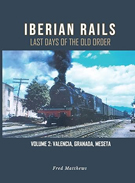
 |
In this second volume about his journeys riding on the Iberian rails, the author and his friend Larry Veysey travel the railway in various Spanish towns including Valencia, Alicante, Granada, and along the Bay of Biscay. In their journeys, it is clear that the traditional way of travel is at the brink of modernization, and things are about to change for better or worse. The memoir takes place in the early sixties, and at that time, some of the railways are still being powered by steam, and coaches are described as “wood-bodied.” The transportation system is compared to early twentieth-century American railways.
This is a short book that is packed with a lot of valuable information, although some of this information may be confusing at times, Matthews does his best to explain everything in full detail and with clarity, which immensely helps in the reading process. Matthews also uses other works as examples, such as Trevor Rowe’s Railway Holiday in Spain, to enhance what he’s trying to Illustrate. This work isn’t just about the history of Spanish travel but is also a look at how, even almost thirty years later, the Spanish Civil War still affected these places socially and economically. The book is lavishly illustrated with often breathtaking photographs of the Spanish railway scene in the 1960s. Matthews's second volume about the Iberian Rails is a fascinating and educational read to the very end.